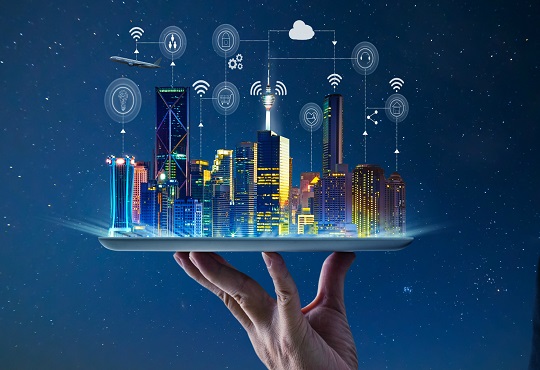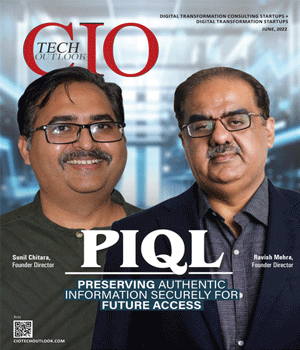
12 Technologies that Helped Enterprises Overcome Pandemic's Impact in 2021
Janifha Evangeline | Tuesday, 21 December 2021, 14:39 IST

During the height of the covid-19 pandemic, most of the organizations and businesses would have come to a complete halt if not for the cutting-edge solutions offered by the tech industry. In order to fight the threat of the Coronavirus, several organizations have deployed work-from-home policies for employees. While travel and business trips were canceled, the use of audio/web conferencing and data-sharing tools by organizations increased rapidly.
Here is the list of 12 technologies that helped organizations across the world during the pandemic and brought in new changes on how employees would work during such situations.
Cloud Computing
The pandemic has revealed a new reality. The new reality is that the cloud is highly essential for keeping businesses running. Right from new remote workforces to virtual meetings, businesses and organizations had to make critical adjustments in order to survive. And, these include adopting and using more cloud services.
Although Cloud computing was already ubiquitous, the covid-19 pandemic accelerated its use. It became one of the most important technical foundations for agility, and flexibility. Cloud computing has been key to success and the transformation of business models as well as customer experiences which organizations needed to respond to the pandemic.
“Cloud has all but becomes the foundation for innovation, and hybrid cloud environments are on the rise. Most forward-looking enterprises are actively crafting hybrid cloud strategies to accelerate growth recovery and improve business agility to sustain success in the new decade,” says Srikanth D, VP-Hybrid Cloud Systems, Oracle India.
“It’s well-established that enterprises with a well-integrated and balanced hybrid cloud strategy are gaining greater business benefits than a piece-meal or fragmented approach to cloud,” he adds.
Unified Communication and Collaboration tools
Unified Communications is more than just a phone system - it is a tightly integrated communication platform connecting businesses/users across multiple platforms and locations. Many SMBs are using unified communication and collaboration tools to transition to a remote-first workforce and are embracing the technology.
“The “bring your own device” (BYOD) has taken up a large hold within organizations of all sizes, I have personally seen the trend how the industry has evolved extensively, the corporates who solely relied on Video Conferencing for communicating via the dedicated VC rooms or VOIP based Conference bridges breaking the tradition and moving towards a more comfortable integrated system of UC solution integrating their mobile phones, laptops, VC rooms, and their traditional desk phones,” says Atul Ahuja, MD, Softline Group.
Computer-Assisted telephone interviews
Computer-assisted telephone interviewing has been very valuable and helpful during the lockdown owing to the pandemic. One of the significant advantages of Computer Assisted Telephone interviews is that they can be done with any kind of phone and enables equity and inclusion, which allows researchers to gather data from numerous and diverse participants.
Financial Process Automation
As organizations move into their new work structures, there is a lot of funding going into tools in order to support distributed workforces. This will continue to be pivotal especially for the finance departments who need to automate financial processes as much as possible - no matter where they are working from. They can focus more on important strategic initiatives to drive the business forward.
“Automation is all set to transform the BFSI sector in India. However, to deliver business efficiencies and improve service quality, individual technologies cannot function in silos. Automation has to be a heady mix, which is thought through to deliver the desired result. This mixology is unfolding today in the BFSI sector,” says Ulhas Kulkarni, SVP – Process Automation & RPA, Datamatics Global Services Ltd.
“We are witnessing a “dynamic automation” or a “technology convergence” involving Robotic Process Automation (RPA), Artificial Intelligence (AI) / Machine Learning (ML), Analytics, Natural Language Processing (NLP), and Intelligent Data Capture or Intelligent Optical Character Recognition (OCR). Referring to as “Intelligent Automation”, the mashup is empowering businesses to go beyond point solutions and move towards a holistic approach to solve complex business problems,” he adds.
Embedded financial technology
Embedded financial technology has always been a winner even before the pandemic phase and will continue to grow in the post-pandemic space. Nonbank companies are rendering financial services such as digital wallets, payments, and lending. Non-bank providers have been integrating financial services into a wide range of marketplaces as well as services. This disruptive trend of technology has been playing a significant role in the lives of consumers and businesses and companies in a wide range of industries such as retail, logistics and technology, telecommunications, food, transportation, hospitality are building embedded financial services to serve business and consumer landscapes.
Intelligent Security Technology
Owing to multiple security risks faced by organizations during the pandemic, the cybersecurity industry has accentuated and brought in innovation. Specifically, intelligent security technology which can mitigate insider breaches has facilitated enterprises to protect their data from being stolen. Furthermore, seeing a future of long-term hybrid working on the horizon, organizations will have to be more proactive when it comes to risks within the organizations.
“A closer look at the sources of cyber-attacks reveals that a significant portion of security breaches are now indirect, as threat actors target weaker links in the supply-chain or business ecosystem. Spoofed websites pertaining to Non-Governmental Organizations (NGOs) working for COVID-19 related welfare and phishing attacks focusing on COVID-19 related news are increasingly being used by the cyber attackers to penetrate networks,” says Rajesh Dhuddu, Blockchain & Cybersecurity Practice Leader, Tech Mahindra.
“Cybersecurity is becoming an important discussion point at board meetings because it has been resulting in damages on account of loss of reputation and loss of productivity. It is imperative that we create cyber resilient businesses which bring together the capabilities of cyber security, business continuity, and enterprise resilience in order to become fit for the future,” he adds.
Virtual Reality
Unlike AR, Virtual Reality has also helped in shaping enterprise 4.0 journeys. Many of the production enterprises have begun using VR technology to promote their products. Consumers or end-users can utilize this technology for viewing product designs and suggesting subsequent changes that are required in the product. This not only saves valuable resources for the companies but also enriches the customer experience.
“Augmented and virtual reality led technologies have ruled a lot of conversation in the past few years, along with the rise of Enterprise 4.0 which has brought multiple business process efficiency possibilities for different industry verticals like virtual agents having started serving the customers, analytics predicting the customer needs, augmented reality improving communication and robotics and artificial intelligence allowing new ways to increase efficiency by having automated the back office,” says Feroz Khan, Associate Director – Head Digital Technology Excellence, The Boston Consulting Group.
Artificial Intelligence
We are living in the middle of an era of AI renaissance which has been accelerated during the covid-19 pandemic. In order to reinvent themselves and to stay ahead of the curve in the long term, organizations are utilizing this as a huge opportunity and leveraging Artificial Intelligence. This AI renaissance and will be a game-changer post-pandemic and will be seen the move to a tech driver from a tech enabler, which will make it a vital piece of the overall business strategy that helps drive long-term value.
Cybersecurity vendors
Cybersecurity vendors play a major role today. A large number of hacks begin with employees who are not careful with login credentials such as passwords or even their laptops. Now owing to the pandemic, those same laptops when taken home make the cyber risk much higher for organizations. Therefore, finding cyber tools for protecting those assets has become one of the topmost priorities for organizations, while this also applies to networks & mobile devices as well.
Personal surveillance technology
This technology became a critical tool to stem the spread of the pandemic. The video surveillance market is anticipated to reach USD 75 billion by 2025.
In the United States, one of the famous social media platforms is leading a consortium of organizations and researchers from diverse universities, called the Covid-19 Mobility Data Network and this collaboration intends to help local officials in assessing the effectiveness of social distancing by utilizing data from mobile devices.
Internet Broadband providers
According to a report related to broadband, the lockdown to control coronavirus infection came as a "godsend" to the fixed-line broadband industry, which was struggling with stagnancy in subscribers in the last 4 years.
Furthermore, internet broadband providers are the clear winners as most of the organizations that provided employees with the work from home option helped them increase their broadband speeds and capacities in order to cope up with the increased bandwidth requirement for working from home.
Automation technology & robotics
As the pandemic set in, organizations and industries found themselves facing unfortunate situations where they had to close down factories. Big players like amazon had to face criticism for keeping warehouses open and endangering the safety of the employees. This is where automation came into the picture and enterprises that specialized in industrial automation & robotics have seen a rise in demand as factories found ways to keep assembly lines moving.
CIO Viewpoint
The Constantly Evolving Technology Landscape in...
By Janifha Evangeline
Navigating the Digitalization of Mining Industry
By Janifha Evangeline
How To Achieve An Effective Digital Transformation
By Yogendra Singh, Head-IT/SAP, Barista Coffee Company Limited
CXO Insights
No-code platforms: Enterprise-wide Adoption...
By Rahul Murthi, Director at Acies
Unleashing the Potential of IT in Engineering...
By Gyan Pandey, Head - Digital/CDO, Voltas
Low Code and Artificial Intelligence - The...



.jpg)

.jpg)





